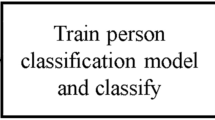Abstract
Presently, the number of children with autism appears to be growing at disturbing rate. Unfortunately, the awareness of early sign of Autism Spectrum Disorder (ASD) is still insufficiently provided to the public. Arm flapping is a good example of a stereotypical behavior of ASD early sign. Typically, a standard Repetitive Behavior Scale-Revised (RBSR) - set of questionnaire - used by clinicians for ASD diagnosis usually involved multiple and long sessions that apparently would delay and may have nonconformity. Thus, we aim to propose a computational framework to semi-automate the diagnosis process. We used human action recognition (HAR) algorithm. HAR involved in human body detection and the skeleton representation to show the arm asymmetrical in arm flapping movement which indicates the possibility of ASD signs by extracting the body pose into stickman model. The proposed framework has been tested against the video clips of children performing arm flapping behavior taken from public dataset. The outcome of this study is expected to detect early sign of ASD based on asymmetry measurement of arm flapping behavior.
Access this chapter
Tax calculation will be finalised at checkout
Purchases are for personal use only
Similar content being viewed by others
References
McCary, L.M., Grefer, M., Mounts, M., Roberts, J.E.: The Importance of Differential Diagnosis in Neurodevelopmental Disorders: Implications for Idea. American Psychological Association, Washington, D.C. (2012)
Mesibov, G., Adams, L., Klinger, L.: Autism: Understanding the Disorder. Plenum Press, New York (1997)
Schertz, H.H., Baker, C., Hurwitz, S., Benner, L.: Principles of early intervention reflected in toddler research in autism spectrum disorders. Top. Early Child. Spec. Edu. 31(1), 4–21 (2011)
Liaw, L.C.B.@.A.: Phenomenological Study an Explanatory on Parents of Autistic Children in Kuching, Sarawak (2008)
Boyd, B.A., Shaw, E.: Autism in the classroom: a group of students changing in population and presentation. Prev. Sch. Fail. 54(4), 211–219 (2010)
Susan, L.H., Patricia, M.R., Davidson, P.: Pervasive developmental disorders in young children. J. Am. Med. Assoc. 285, 3141–3142 (2001)
Watson, L.R., Baranek, G.T., Crais, E.R., Hughes, C., Kristof, M.L., Zanzot, E.: Gesture use of infants with autism at 9–12 months. In: The American Speech-Language-Hearing Association Convention (2000)
Goodwin, M.S., Intille, S.S.: Recognizing stereotypical motor movements in the laboratory and classroom: a case study with children on the autism spectrum. In: Proceeding of the 11th International Conference on Ubiquitous Computing (2009)
Westeyn, T., Vadas, K., Bian, X., Starner, T., Abowd, G.D.: Recognizing mimicked autistic self-stimulatory behaviors using HMMs. In: Proceedings of ISWC, pp. 164–169 (2005)
Azizul, Z., Muty, N.: Detecting arm flapping in children with autism spectrum disorder using human pose estimation and skeletal representation algorithms. In: International Conference on Advanced Informatics: Concepts, Theory and Application (2016)
Sigal, L.: Human pose estimation. In: Ikeuchi, K. (ed.) Computer Vision, pp. 362–370. Springer, New York (2014). doi:10.1007/978-0-387-31439-6_584
Buehler, P., Everingham, M., Huttenlocher, D.P., Zisserman, A.: Long Term Arm and Hand Tracking for Continuous Sign Language TV Broadcasts (2008)
Teitelbaum, O., Benton, T., Shah, P.K., Prince, A., Kelly, J.L., Teitelbaum, P.: Eshkol–Wachman movement notation in diagnosis: the early detection of Asperger’s syndrom. Proc. Natl. Acad. Sci. U.S.A. 101, 11909–11914 (2004)
Bai, X., Latecki, L.J.: Path similarity skeleton graph matching. IEEE Trans. Patt. Anal. Mach. Intell. 30(7), 1282–1292 (2008)
Esposito, G., Venuti, P., Apicella, F., Muratori, F.: Analysis of unsupported gait in toddlers with autism. Brain Dev. 33, 367–373 (2011)
Hashemi, J., Spina, T.V., Tepper, M., Esler, A., Morellas, V., Papanikolopoulos, N., Sapiro, G.: Computer vision tools for the non-invasive assessment of autism-related behavioral markers. In: Development and Learning and Epigenetic Robotics, pp. 1–7 (2012)
Rajagopalan, S.S., Dhall, A., Goecke, R.: Self-Stimulatory Behaviours in the Wild for Autism Diagnosis (2013)
Muhammad, A., Surip, S.S., Harris, B., Mohamed, A.S.A.: Interactive sign language interpreter using skeleton tracking. J. Telecommun. Electron. Comput. Eng. (JTEC) 8, 137–140 (2016)
Ravi, P.L., Ruhaiyem, N.I.R.: Intelligent gameplay for improved retro games. J. Telecommun. Electron. Comput. Eng. (JTEC) 8(6), 23–26 (2016)
Noor Muhammad, M.A., Ruhaiyem, N.I.R., Mohamed, A.S.A.: Keeping curiosity in local historical knowledge alive by sensor based simulation game using flash actionscript 3. In: Proceedings of the International Conference Local Knowledge (2016)
Acknowledgments
The authors wish to thank Universiti Sains Malaysia for the support it has extended in the completion of the present research through Short Term University Grant No: 304/PKOMP/6313259.
Author information
Authors and Affiliations
Corresponding author
Editor information
Editors and Affiliations
Rights and permissions
Copyright information
© 2017 Springer International Publishing AG
About this paper
Cite this paper
Yaakob, A.D.A., Ruhaiyem, N.I.R. (2017). Measuring the Variabilities in the Body Postures of the Children for Early Detection of Autism Spectrum Disorder (ASD). In: Badioze Zaman, H., et al. Advances in Visual Informatics. IVIC 2017. Lecture Notes in Computer Science(), vol 10645. Springer, Cham. https://doi.org/10.1007/978-3-319-70010-6_47
Download citation
DOI: https://doi.org/10.1007/978-3-319-70010-6_47
Published:
Publisher Name: Springer, Cham
Print ISBN: 978-3-319-70009-0
Online ISBN: 978-3-319-70010-6
eBook Packages: Computer ScienceComputer Science (R0)




